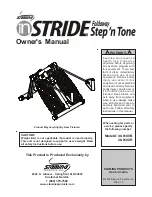
72 |
www.HandiQuilter.com
Moving the machine too fast for
needle speed selected (Manual
mode)
• Synchronize machine movement and needle speed to get roughly
8 to 10 stitches per inch. Elongated stitches are an indication of
moving the machine too fast for the current speed.
Tension is Poor
Corrective Measure(s)
Lint caught under the tension
spring in the bobbin
• If using short staple threads, inexpensive, or industrial threads,
or coated threads, lint and other material will build up under the
tension spring and begin to lift the spring, reducing the spring’s
ability to compress against the thread. Insert a needle or business
card under the spring and clear out the lint. The bobbin tension
will return fairly close to its preset tension. Test the tension before
quilting.
Hand Wheel Won’t Rotate
Corrective Measure(s)
Thread is entangled and caught
in the hook
• There may be a thread lock. With the machine on, use the on-
screen hand wheel to break the thread lock. Quickly move
your finger down and up several times. If this doesn’t solve the
problem, turn the machine off and use the handwheel at the back
of the machine to resolve the thread lock.
Thread Nests Under Quilt
Corrective Measure(s)
Not enough tension on top
thread
• Check that the machine is threaded correctly. Make certain that
the thread is flossed snugly in place between the two tension
discs. If the machine is threaded correctly, tighten top tension by
rotating the tension knob clockwise. (For more information about
adjusting tension, see
Bobbin and Bobbin Tension
and
Easy-Touch
Tension™
in the
Using Your Machine
section of this manual.)
Improper threading
• Refer to threading diagram and threading instructions.
Thread Backlash
Corrective Measure(s)
Bobbin thread tangles within
the bobbin case, tangles and
winds onto the hook spindle, or
occasionally forms loops on the
bottom of the quilt.
• The bobbin should sit in the bobbin case such that one side is
very minimally above the edge of the bobbin case and if you
lightly press down on the bobbin, it descends slightly into the
case. To adjust the backlash spring, place the bobbin in the case
and hold it with the bobbin facing up. Then use a tiny screw
driver to adjust the screw on the outside front shiny surface of
the bobbin case (not the screw inside the bobbin case). Turn the
screw counterclockwise to raise the backlash spring (and raise
the bobbin) or turn it clockwise to lower the backlash spring
(and lower the bobbin). After making an adjustment, reinsert the
bobbin into the machine, bring up the bobbin thread, and test
stitching. Make additional adjustments if necessary.
















































